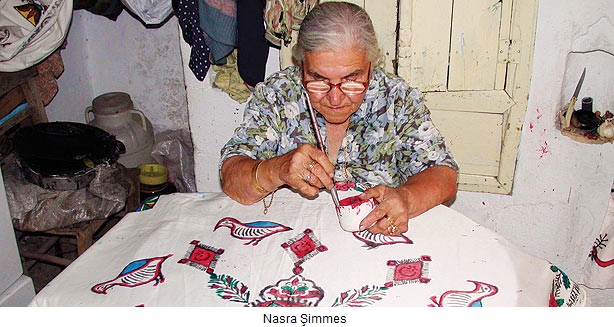

 Mardin, Turkey -- Nasra Şimmes Çilli is 88 years old. She is from Mardin. She doesn't speak Turkish, and she can neither read nor write, but she was honored as the Woman of the Year by Prime Minister Recep Tayyip Erdoğan on International Women's Day.
Mardin, Turkey -- Nasra Şimmes Çilli is 88 years old. She is from Mardin. She doesn't speak Turkish, and she can neither read nor write, but she was honored as the Woman of the Year by Prime Minister Recep Tayyip Erdoğan on International Women's Day.
She is the last of generations of basma artists, who use a technique of printing on fabric that has decorated the walls of Syriac Orthodox churches for centuries. She finds her inspiration in Mardin, her hometown and her motherland. Her children have moved to different parts of the world -- all inviting her to stay with them -- but she understandably refuses. If she leaves, she will lose her inspiration.
Basma is the ancient art of using paint derived from plant roots to create shapes and patterns on fabric, curtains and walls. She either uses wooden moulds to create these patterns or she draws them on paper from her imagination.
The tradition has existed in Mardin for 600 years. Çilli's father was an artist and a sculptor and, unbeknownst to himself, a teacher to his daughter: "My father did not teach me how to do this. I learned by watching him," she says. She still uses the same wooden molds and brushes used by her father 50 years ago. She draws motifs on cotton cloth and colors them. Sometimes she forgets herself for months at a time and dedicates all her time to imprinting a big pattern on a relatively large cloth. Her grandchildren have had to stop her. "When I work, I feel like I am detached from this world and its mundane negativities."
Çilli rarely leaves her house, which faces the great plain of Mesopotamia -- the soil that she was born on. The main room in the house serves as her day-to-day living space, as well as her workshop. She feels compelled to remind her visitors, over and over again, that guests are always welcome in her house; her door is always open. Most of her artwork is inspired by Mardin's famous stone buildings, streets and traditional handcraft patterns. Most of the patterns are her own drawings. She uses birds a lot in her patterns, saying they symbolize freedom. She loves to use vivid shades of yellow, dark blue, red and green.
But her name is not only familiar among Arameans. Her fame has swept throughout every part of Turkey, as well many countries around the globe. Her ritual cloths, painted using root dyes, adorn churches all over the world.
She enjoys the fame, but perhaps not for the most obvious reason. "My ritual cloths are used in churches in many countries," she told the Cihan news agency in 2009. "But I am happy about more than just that; my cloths represent and promote Mardin."

or register to post a comment.